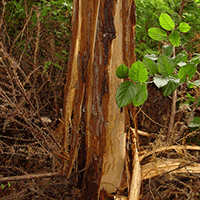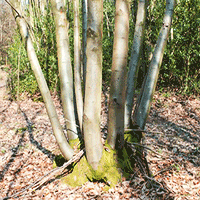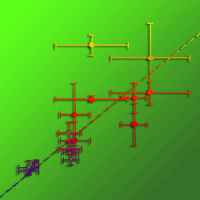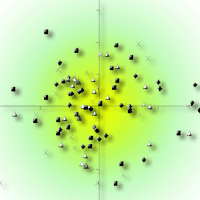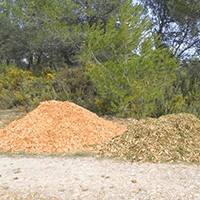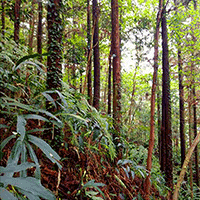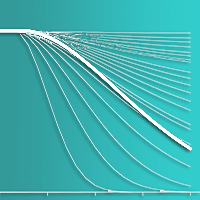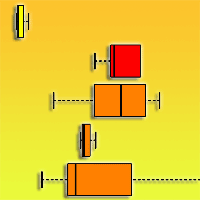
The conversion into high forest of Turkey oak coppice stands: methods, silviculture and perspectives
Maria Chiara Manetti (1) , Claudia Becagli (1), Giada Bertini (1), Paolo Cantiani (1), Maurizio Marchi (2), Francesco Pelleri (1), Dalila Sansone (1), Gianfranco Fabbio (1)
iForest - Biogeosciences and Forestry, Volume 13, Issue 4, Pages 309-317 (2020)
doi: https://doi.org/10.3832/ifor3483-013
Published: Jul 10, 2020 - Copyright © 2020 SISEF
Research Articles
Abstract
The goal of this study is to assess the impact of different thinning approaches for coppice conversion into high forest of Turkey oak stands in Italy. The stand structure and the tree/shrub diversity were analyzed in 27 long-term monitoring plots from 7 experimental trials in the Colline Metallifere district (Tuscany, Central Italy) to verify the consistency of the original cultivation goals with the current stand structures. Three different approaches were applied from 1969 onwards: thinning from below, selective thinning, and no-management. Three indexes of specific diversity (Specific Richness, Shannon index and Importance Value) and two indexes of vertical diversity (Vertical Evenness and Coefficient of variation of tree height) were used to analyze and compare the outcome of management practices. The results showed a significantly higher dimensional variability and basal area, and a more complex vertical diversity in control plots and in the plots subject to selective thinning, as compared with plots subject to thinning from below. Tree species richness was high in all plots, independently of the thinning type applied. Based on our results, we suggest Turkey oak-dominated transitory stands to be initially managed by thinning from below, which is easy to be implemented and economically feasible. Selective thinning may be applied later with the aim of promoting sporadic but valuable tree species and increasing tree species diversity.
Keywords
Forest Monitoring, Thinning from Below, Selective Thinning, Biodiversity, Mediterranean Area
Authors’ Info
Authors’ address
Claudia Becagli 0000-0001-5182-2352
Giada Bertini 0000-0003-0882-3127
Paolo Cantiani 0000-0001-8179-2115
Francesco Pelleri 0000-0003-2055-0280
Dalila Sansone
Gianfranco Fabbio 0000-0002-3407-4994
Council for Agricultural Research and Economics, Research Centre for Forestry and Wood (CREA-FL), v.le Santa Margherita 80, I-52100 Arezzo (Italy)
CNR - Institute of Biosciences and BioResources (IBBR), v. Madonna del Piano 10, I-50019 Sesto Fiorentino, FI (Italy)
Corresponding author
Paper Info
Citation
Manetti MC, Becagli C, Bertini G, Cantiani P, Marchi M, Pelleri F, Sansone D, Fabbio G (2020). The conversion into high forest of Turkey oak coppice stands: methods, silviculture and perspectives. iForest 13: 309-317. - doi: 10.3832/ifor3483-013
Academic Editor
Marco Borghetti
Paper history
Received: Oct 10, 2019
Accepted: Apr 30, 2020
First online: Jul 10, 2020
Publication Date: Aug 31, 2020
Publication Time: 2.37 months
Copyright Information
© SISEF - The Italian Society of Silviculture and Forest Ecology 2020
Open Access
This article is distributed under the terms of the Creative Commons Attribution-Non Commercial 4.0 International (https://creativecommons.org/licenses/by-nc/4.0/), which permits unrestricted use, distribution, and reproduction in any medium, provided you give appropriate credit to the original author(s) and the source, provide a link to the Creative Commons license, and indicate if changes were made.
Web Metrics
Breakdown by View Type
Article Usage
Total Article Views: 40282
(from publication date up to now)
Breakdown by View Type
HTML Page Views: 35197
Abstract Page Views: 2336
PDF Downloads: 2055
Citation/Reference Downloads: 7
XML Downloads: 687
Web Metrics
Days since publication: 1984
Overall contacts: 40282
Avg. contacts per week: 142.12
Citation Metrics
Article Citations
Article citations are based on data periodically collected from the Clarivate Web of Science web site
(last update: Mar 2025)
(No citations were found up to date. Please come back later)
Publication Metrics
by Dimensions ©
Articles citing this article
List of the papers citing this article based on CrossRef Cited-by.
References
The coppice area in Italy. General aspects, cultivation trends and state of knowledge. Annali Istituto Sperimentale Selvicoltura, Arezzo 23: 292-298.
Gscholar
Treatment of Turkey oak (Quercus cerris L.) coppice. Structure, biomass and silvicultural options. Annali Istituto Sperimentale Selvicoltura, Arezzo, vol. 27, Special issue MedCop, pp. 121-129.
Gscholar
Silvicultural treatment of Turkey oak stands of agamic origin and enhancement of the value of timber obtained from thinnings. Annali Istituto Sperimentale Selvicoltura, Arezzo, vol. 27, Special issue MedCop, pp. 201- 207.
Gscholar
Intensity of standards release and shoots dynamics in a Turkey oak (Quercus cerris L.) coppice. First contribution. Annali Istituto Sperimentale Selvicoltura, Arezzo, vol. 27, Special issue MedCop, pp. 105-111.
Gscholar
Technological characterization of Turkey oak solid wood panels. Annali Istituto Sperimentale Selvicoltura, Arezzo 27, Special issue MedCop, pp 209-214.
Gscholar
Coppicing in the past - examples of practice, context and consequences. In: Proceedings of the International Conference “Coppice Forests: Past, Present and Future”. Brno (Czech Republic) 9-11 Apr 2015. Book of Abstracts, Vild. O. Ed., Brno, Czech Republic, pp. 136.
Gscholar
Conversion to high forest of Turkey oak coppice: technical and economical assessment of the first conversion stage. Annali Istituto Sperimentale Selvicoltura, Arezzo 27, Special issue MedCop, pp. 191-200.
Gscholar
Soil map of Italy, scale 1:1.000.000. SELCA, Firenze, Italy.
Gscholar
Effects of silvicultural treatment on canopy cover and soil water content in a Quercus cerris L. coppice. Annali Istituto Sperimentale Selvicoltura, Arezzo 27, Special issue MedCop, pp. 65-70.
Gscholar
Towards a sustainable management of Mediterranean forest: the MEDCOP experience (1994-98). In: Proceedings of the “VII International Congress of Ecology, INTECOL”. Florence (Italy) 19-25 July 1998, pp. 295-308.
Gscholar
Aspects of biological diversity at the CONECOFOR plots. I. Structural and species diversity of the tree community. In: Special issue on “Aspects of Biodiversity in Selected Forest Ecosystems in Italy”. Annali CRA-Istituto Sperimentale Selvicoltura, Arezzo 30 (2): 11-20.
Gscholar
Thinning practice. A silvicultural guide. Forestry Commission, Edinburgh, UK, pp. 54.
Gscholar
Coppice woods. temporal and spatial diversity creating rich wildlife assemblages. In: Proceedings of the International Conference “Coppice Forests: Past, Present and Future”. Brno (Czech Republic) 9-11 Apr 2015. Book of Abstracts, Vild. O. Ed., Brno, Czech Republic, pp. 136.
Gscholar
Management of oak forests: striking a balance between timber production, biodiversity and cultural services. International Journal of Biodiversity Science, Ecosystem Services and Management 12 (1-2): 59-73.
CrossRef | Gscholar
Integrating conservation objectives into forest management: coppice management and forest habitats in Natura 2000 sites. iForest - Biogeosciences and Forestry 9 (4): 560-568.
CrossRef | Gscholar
Past, present and future of the coppice silvicultural system in the Italian North-West. In: Proceedings of the International Conference “Coppice Forests: Past, Present and Future”. Brno (Czech Republic) 9-11 Apr 2015. Book of Abstracts, Vild. O. Ed., Brno, Czech Republic, pp. 136.
Gscholar
Sporadic tree species management for preserving biodiversity and increasing economic stands value: the PProSpoT experience. In: Proceedings of the International Conference “Coppice Forests: Past, Present and Future”. Brno (Czech Republic) 9-11 Apr 2015. Book of Abstracts, Vild. O. Ed., Brno, Czech Republic, pp. 136.
Gscholar
Coppice management and nutrition. In: Proceedings of the International Conference “Coppice Forests: Past, Present and Future”. Brno (Czech Republic) 9-11 Apr 2015. Book of Abstracts, Vild. O. Ed., Brno, Czech Republic, pp. 136.
Gscholar
The mathematical theory of communication. University of Illinois Press, Urbana, IL, USA, pp. 29-125.
Gscholar
Aspects of oak (Quercus sp.) management in Spain and its application. In: Proceedings of the International Conference “Coppice Forests: Past, Present and Future”. Brno (Czech Republic) 9-11 Apr 2015. Book of Abstracts, Vild. O. Ed., Brno, Czech Republic, pp. 136.
Gscholar


